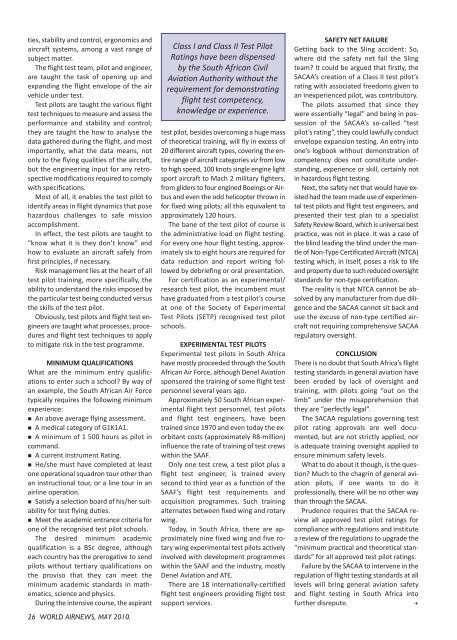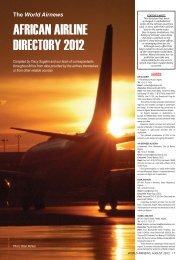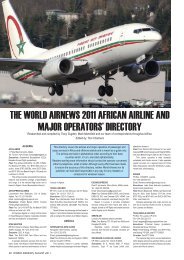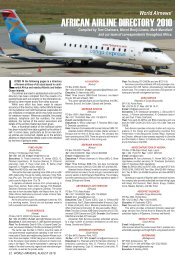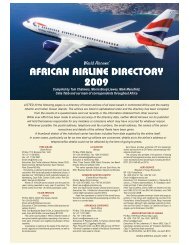May 2010 covers_Covers.qxd - World Airnews
May 2010 covers_Covers.qxd - World Airnews
May 2010 covers_Covers.qxd - World Airnews
You also want an ePaper? Increase the reach of your titles
YUMPU automatically turns print PDFs into web optimized ePapers that Google loves.
ties, stability and control, ergonomics and<br />
aircraft systems, among a vast range of<br />
subject matter.<br />
The flight test team, pilot and engineer,<br />
are taught the task of opening up and<br />
expanding the flight envelope of the air<br />
vehicle under test.<br />
Test pilots are taught the various flight<br />
test techniques to measure and assess the<br />
performance and stability and control;<br />
they are taught the how to analyse the<br />
data gathered during the flight, and most<br />
importantly, what the data means, not<br />
only to the flying qualities of the aircraft,<br />
but the engineering input for any retrospective<br />
modifications required to comply<br />
with specifications.<br />
Most of all, it enables the test pilot to<br />
identify areas in flight dynamics that pose<br />
hazardous challenges to safe mission<br />
accomplishment.<br />
In effect, the test pilots are taught to<br />
“know what it is they don’t know” and<br />
how to evaluate an aircraft safely from<br />
first principles, if necessary.<br />
Risk management lies at the heart of all<br />
test pilot training, more specifically, the<br />
ability to understand the risks imposed by<br />
the particular test being conducted versus<br />
the skills of the test pilot.<br />
Obviously, test pilots and flight test engineers<br />
are taught what processes, procedures<br />
and flight test techniques to apply<br />
to mitigate risk in the test programme.<br />
MINIMUM QUALIFICATIONS<br />
What are the minimum entry qualifications<br />
to enter such a school? By way of<br />
an example, the South African Air Force<br />
typically requires the following minimum<br />
experience:<br />
n An above average flying assessment.<br />
n A medical category of G1K1A1.<br />
n A minimum of 1 500 hours as pilot in<br />
command.<br />
n A current Instrument Rating.<br />
n He/she must have completed at least<br />
one operational squadron tour other than<br />
an instructional tour, or a line tour in an<br />
airline operation.<br />
n Satisfy a selection board of his/her suitability<br />
for test flying duties.<br />
n Meet the academic entrance criteria for<br />
one of the recognised test pilot schools.<br />
The desired minimum academic<br />
qualification is a BSc degree, although<br />
each country has the prerogative to send<br />
pilots without tertiary qualifications on<br />
the proviso that they can meet the<br />
minimum academic standards in mathematics,<br />
science and physics.<br />
During the intensive course, the aspirant<br />
26 WORLD AIRNEWS, MAY <strong>2010</strong>.<br />
Class I and Class II Test Pilot<br />
Ratings have been dispensed<br />
by the South African Civil<br />
Aviation Authority without the<br />
requirement for demonstrating<br />
flight test competency,<br />
knowledge or experience.<br />
test pilot, besides overcoming a huge mass<br />
of theoretical training, will fly in excess of<br />
20 different aircraft types, covering the entire<br />
range of aircraft categories viz from low<br />
to high speed, 100 knots single engine light<br />
sport aircraft to Mach 2 military fighters,<br />
from gliders to four engined Boeings or Airbus<br />
and even the odd helicopter thrown in<br />
for fixed wing pilots; all this equivalent to<br />
approximately 120 hours.<br />
The bane of the test pilot of course is<br />
the administrative load on flight testing.<br />
For every one hour flight testing, approximately<br />
six to eight hours are required for<br />
data reduction and report writing followed<br />
by debriefing or oral presentation.<br />
For certification as an experimental/<br />
research test pilot, the incumbent must<br />
have graduated from a test pilot’s course<br />
at one of the Society of Experimental<br />
Test Pilots (SETP) recognised test pilot<br />
schools.<br />
EXPERIMENTAL TEST PILOTS<br />
Experimental test pilots in South Africa<br />
have mostly proceeded through the South<br />
African Air Force, although Denel Aviation<br />
sponsored the training of some flight test<br />
personnel several years ago.<br />
Approximately 50 South African experimental<br />
flight test personnel, test pilots<br />
and flight test engineers, have been<br />
trained since 1970 and even today the exorbitant<br />
costs (approximately R8-million)<br />
influence the rate of training of test crews<br />
within the SAAF.<br />
Only one test crew, a test pilot plus a<br />
flight test engineer, is trained every<br />
second to third year as a function of the<br />
SAAF’s flight test requirements and<br />
acquisition programmes. Such training<br />
alternates between fixed wing and rotary<br />
wing.<br />
Today, in South Africa, there are approximately<br />
nine fixed wing and five rotary<br />
wing experimental test pilots actively<br />
involved with development programmes<br />
within the SAAF and the industry, mostly<br />
Denel Aviation and ATE.<br />
There are 18 internationally-certified<br />
flight test engineers providing flight test<br />
support services.<br />
SAFETY NET FAILURE<br />
Getting back to the Sling accident: So,<br />
where did the safety net fail the Sling<br />
team? It could be argued that firstly, the<br />
SACAA’s creation of a Class II test pilot’s<br />
rating with associated freedoms given to<br />
an inexperienced pilot, was contributory.<br />
The pilots assumed that since they<br />
were essentially “legal” and being in possession<br />
of the SACAA’s so-called “test<br />
pilot’s rating”, they could lawfully conduct<br />
envelope expansion testing. An entry into<br />
one’s logbook without demonstration of<br />
competency does not constitute understanding,<br />
experience or skill, certainly not<br />
in hazardous flight testing.<br />
Next, the safety net that would have existed<br />
had the team made use of experimental<br />
test pilots and flight test engineers, and<br />
presented their test plan to a specialist<br />
Safety Review Board, which is universal best<br />
practice, was not in place. It was a case of<br />
the blind leading the blind under the mantle<br />
of Non-Type Certificated Aircraft (NTCA)<br />
testing which, in itself, poses a risk to life<br />
and property due to such reduced oversight<br />
standards for non-type certification.<br />
The reality is that NTCA cannot be absolved<br />
by any manufacturer from due diligence<br />
and the SACAA cannot sit back and<br />
use the excuse of non-type certified aircraft<br />
not requiring comprehensive SACAA<br />
regulatory oversight.<br />
CONCLUSION<br />
There is no doubt that South Africa’s flight<br />
testing standards in general aviation have<br />
been eroded by lack of oversight and<br />
training, with pilots going “out on the<br />
limb” under the misapprehension that<br />
they are “perfectly legal”.<br />
The SACAA regulations governing test<br />
pilot rating approvals are well documented,<br />
but are not strictly applied, nor<br />
is adequate training oversight applied to<br />
ensure minimum safety levels.<br />
What to do about it though, is the question?<br />
Much to the chagrin of general aviation<br />
pilots, if one wants to do it<br />
professionally, there will be no other way<br />
than through the SACAA.<br />
Prudence requires that the SACAA review<br />
all approved test pilot ratings for<br />
compliance with regulations and institute<br />
a review of the regulations to upgrade the<br />
“minimum practical and theoretical standards”<br />
for all approved test pilot ratings.<br />
Failure by the SACAA to intervene in the<br />
regulation of flight testing standards at all<br />
levels will bring general aviation safety<br />
and flight testing in South Africa into<br />
further disrepute. Q


